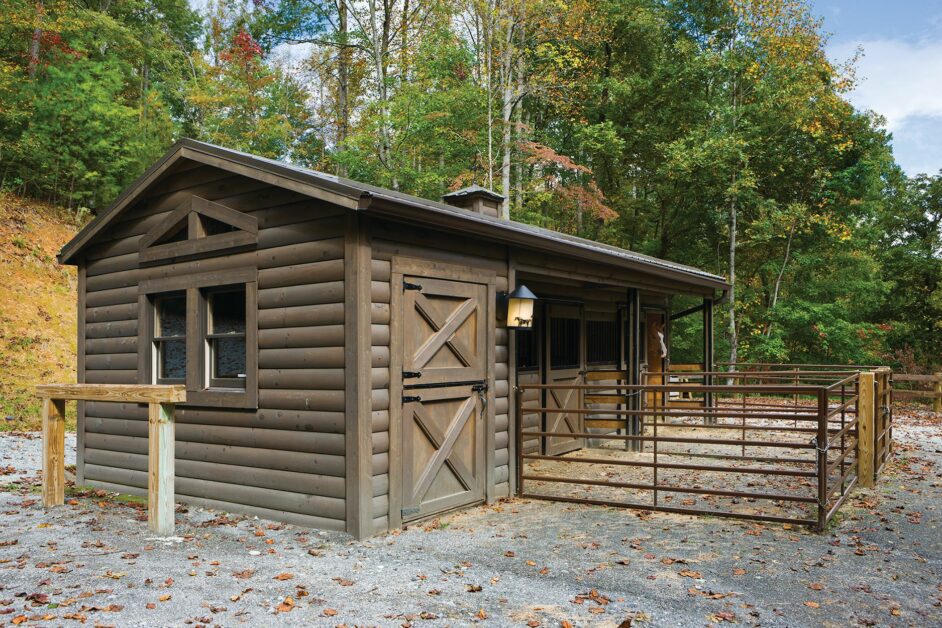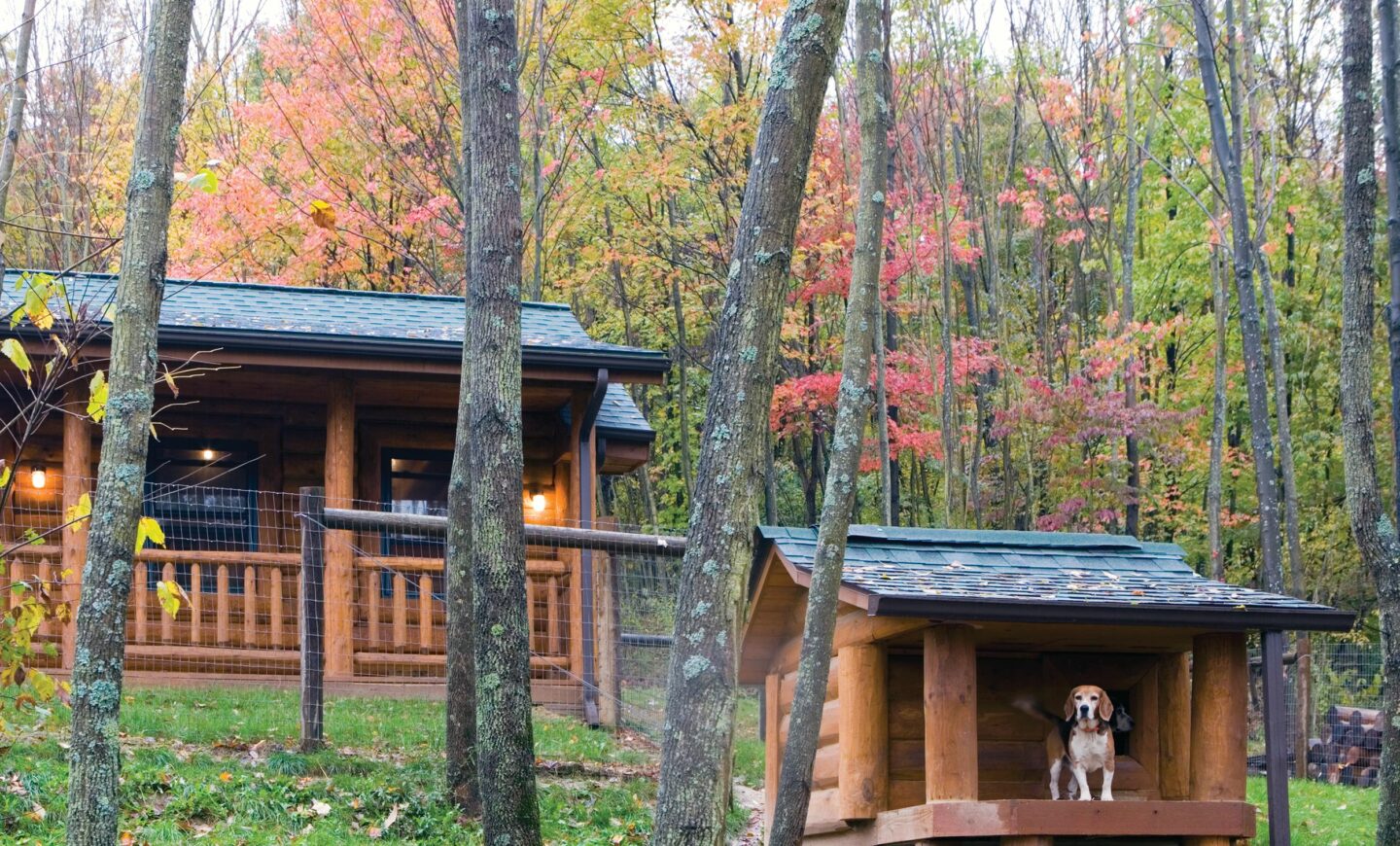Don’t forget the furry, feathered, or finned residents when planning your home living spaces.
When the time comes to design the log or timber home that meets the needs of a family, the exercise includes the “entire” family. Pets are part of the lifestyle for many, and their needs are addressed in a variety of ways.
Design and architectural firms are regularly asked to include features that accommodate dogs and cats or other animals that enrich the lives of their owners in so many ways. “I believe it is safe to say that most of our log and timber home customers have pets and that most people want to improve their current situation,” acknowledges Tod Parmeter, co-owner of Golden Eagle Log Homes, which offers its own in-house design team.
“We custom design every home we sell,” Tod adds, “so when a customer asks for a room or special area for their pets we try to give them what they want and show them options they may never have considered.” Such options include spaces specially designed for cats or dogs during their leisure hours, their playtime, and their indoor and outdoor periods—each with convenience, style, and peace of mind for their homeowner built in.
MossCreek is an independent design firm that provides custom services along with more than 100 predrawn log or timber home floorplans. “We are always sure to ask customers if they have any pets, how many, and what size during our design discussions,” comments MossCreek President Allen Halcomb. “Once we know that, we are sure to allow for those pets.”
Spaces may be dog or cat specific, located in appropriate areas of the home, and custom sized for the pet’s access. “We have designed cat specific rooms as well as indoor dog kennels, dog runs, and bathing areas,” says Halcomb. “The size for such a room would be based on the size and number of pets that will be using it.”
Parmeter’s experience with cats suggests that they prefer lofted homes and bedrooms located in a loft setting. Cats, he says, “seem happiest warming themselves by the loft window seat area and contemplating their situation from above.”

For dogs, size really matters. Halcomb advises homeowners to consider play areas that are appropriate along with locations in the home, construction materials, and environmental concerns. “We will often encourage clients to make provisions inside a home for larger dogs,” he reasons. “Smaller dogs don’t have quite the same space requirements. If dogs are present we would caution against using wood floors that may be a ‘softer’ species to prevent claw marks and scratches. Also, if need be, we remind our clients to make sure their HVAC systems sufficiently filter the air if several pets are present. Rooms are best located near a den or in areas where the flooring materials are more likely to be pet safe. On an outside wall is also good, allowing natural light and giving the pet a view to the outside.”
Living with and loving large or small dogs gives rise to some design creativity, and Parmeter has provided his two canines, Angel and Saint, with something special. “We have our home set up so the dogs can come and go as they please without human interaction,” he explains. “Angel and Saint go out to play and do their business in an area we affectionately call a ‘Zen Garden.’ Our ‘Zen Garden’ comes complete with apple trees and is fenced in with cast iron open-view decorative fencing. Their play area is very low maintenance; their walking surface is 100 percent pea gravel-sized smooth stones that quickly drain away water.”
“Speaking of water,” he continues, “in the summer months we have underground sprinklers that pop up twice a day to keep the rocks cleansed and aroma free. When Saint and Angel are ready to come back into the house they pass through a pet door followed by a sun-warmed air-locked corridor followed by another pet door. We experience almost zero heat loss from the pet doors, which are always on call.”
Of course, pet spaces aren’t limited to cats and dogs. The MossCreek design team has configured a large aviary for one client who owns numerous birds and designed floor-to-ceiling aquarium walls for another with fish as pets.
“We once designed an exterior shower area as part of the home for a pet horse that was never fenced and never ran off,” smiles Tod. “This same client had a Mr. Ed door just off their kitchen area so her horse could look in and see what was cooking. This client took great delight in feeding her horse carrots and sugar cubes right from her kitchen door.”
One of the most popular pet-friendly elements of many log and timber homes is the mud room equipped as a pet wash, particularly for dogs that have roamed outdoors for a few hours. Parmeter frequently designs heated mud rooms complete with pet showers and locates them between the “Zen Garden” and the home’s living area, off a rear entry, garage, or laundry space. An extra door prevents the dog from entering the main areas. He also recommends no-slip tile flooring to help larger dogs with hip stability and a minimum space allotment of eight feet by 12 feet.
“Often these rooms are equipped with a countertop with a sink area, spare refrigerator, and cabinetry space for food prep and toy storage,” says Tod. “In addition, some clients want cameras to check on their pet. One customer requested a flat screen TV because his dog loved to watch Fox News.”
Pet washes or mud rooms are essential for homes located near lakes or in areas that receive large amounts of snow, advises Halcomb. “Unless it’s a very small dog, a floor sink with a hand-held shower head is the best option. The floors and walls should be all tile to be safe from ‘dog shaking.’ In a perfect scenario, the whole room would be considered a ‘wet room.’ They should include shelving, and direct access to outside is all the better. Mud rooms would be similar to pet wash areas in materials and finishes. They should be warmed, even with a radiant heat floor, and ideally co-located with a ‘people mud room.’”
Log and timber homeowners add to the functionality and enjoyment of their homes when purpose-built pet spaces are included—and the pets themselves will offer a purr of approval or wag of the appreciative tail.

